(Mis)adventures in the world of musical instrument repair. Also lots of photos of shiny things, and assorted other musical mischief.
Don't wanna be here? Send us removal request.
Text


Rotor from a Hirsbrunner tuba. The delrin insert is to reduce weight.
#musical instrument repair#music#brass instrument#brasswind#musical instrument#tuba#Hirsbrunner#rotary valves#I *think* the little circles visible on the outer surface are from a rod through the brass into the delrin to hold it in place#but I'm not 100% sure on that because this is the first time I have seen these in person nor have I seen a cutaway diagram
0 notes
Text

I am usually pretty good at avoiding the needle springs* on clarinets and saxes, but I stabbed myself like twenty fucking times while overhauling this thing. Glad to finally be done. At least it plays real nice.
*Anyone want to guess why they are called needle springs? Go on, take a guess.
#musical instrument repair#music#musical instrument#woodwind#clarinet#buffet crampon#has a really nice tone and blows easily#goddamn needle springs#overhaul#I need to go dig up the Before photos#this thing was nasty#never cleaned as much goo out of the register and thumb tubes as I did on this one
0 notes
Text


Stacked cardboard slices used as top cap valve felts.
Y'know what? As far as improvised fixes go, this is fine. Should have been replaced with proper felts way sooner — these have been on here for a while, judging by the state of the cardstock — and not as good at dampening the sound as felt, but it does an acceptable enough job, is easily reversible, and I don't have to spend an hour cleaning dribbles of superglue off of anything.
1 note
·
View note
Text

Been a while since I have had to do a full clean on a BE994. Forgot how heavy these things are when full of water.
#musical instrument repair#brass instrument#music#brasswind#musical instrument#tuba#Bb tuba#Besson#BE994#they're like twelve kilos empty#need to get back into doing deadlifts at the gym#so it gets easier lifting these out of the ultrasonic tank
0 notes
Text

Old vs. new saxophone key pad.
#musical instrument repair#music#musical instrument#woodwind#saxophone#key pads#old vs new#plays a lot better with a pad that seals the tone hole#if there are major leaks near the top of the instrunent it affects the playability of every note below
0 notes
Text


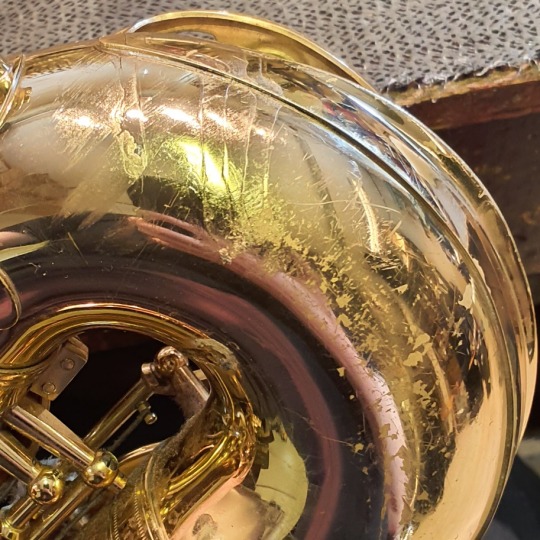
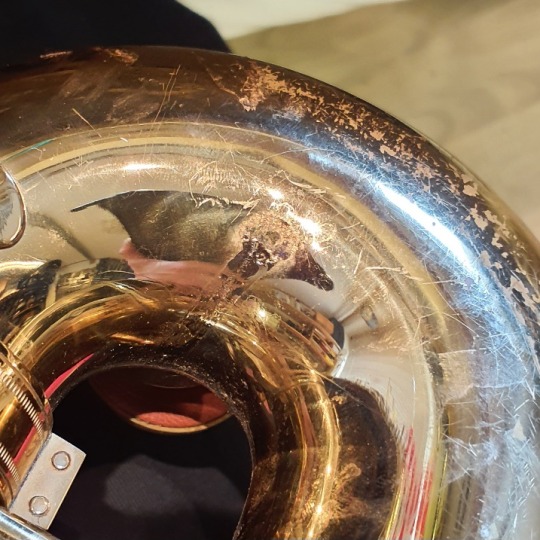
Saxophone in for a repair estimate.
Me: Looks like definitely one pad needs to be replaced, probably some new felts and corks, key adjustments everywhere, and one of the key guard feet needs to be resolder— is this glue?
Customer: Yeah I glued it back down when it broke off.
Me: ...Did you use superglue?
Customer: No idea. It was called "fast glue".
Me: Yeah, that's superglue. Okay, that's at least an extra half an hour of work to clean all this off because I'm not soldering around superglue due to really noxious fumes.
Customer: lol just leave it then; I don't want to pay extra for that
Me: Just... leave it unsoldered?
Customer: Yep.
Me: You're sure? Just leave it loose like this?
Customer: Yah.
Me: ...Fine. I'll throw a zip-tie over it or something to keep it in place.
Me: *screaming inside*
#musical instrument repair#music#woodwind#saxophone#it's a YAS-62 too so it's a *good* instrument#superglue#again#for the love of fuck stop putting superglue on your instruments#there are certain cases where we do in fact use superglue#repairing chips and cracks in wooden instruments for example#this is not one of those times#superglue is not an acceptable substitute for solder
1 note
·
View note
Text
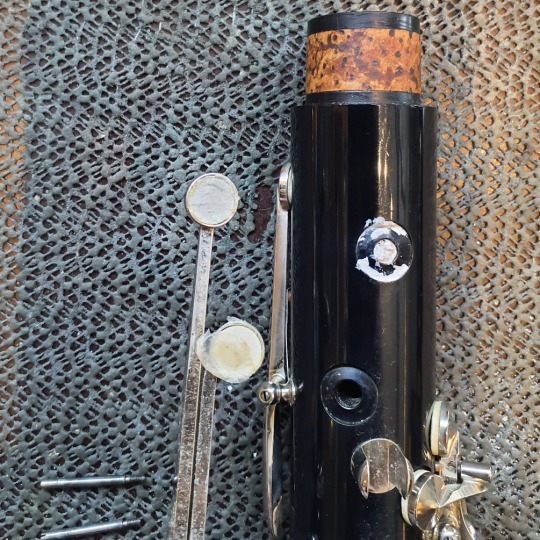
Client hands me a clarinet case: Clarinet doesn't play.
Me: Did the player offer any info more detailed than that? Specific notes that sound off or keys that feel wrong?
Client: Nope, just that it isn't working.
Me, opening the case: The C- and B-trill key pads are both missing.
Client: Ah. That would do it.
Me: Also the C-trill tone hole is full of goo — looks like someone tried to emergency-fix the missing C-trill pad with a lump of some kind of poster adhesive — five out of six pads on the lower joint are falling apart, and several key corks have fallen off.
Client: This isn't a simple while-you-wait fix, is it?
Me: Depends on how long you're willing to sit and wait.
2 notes
·
View notes
Text





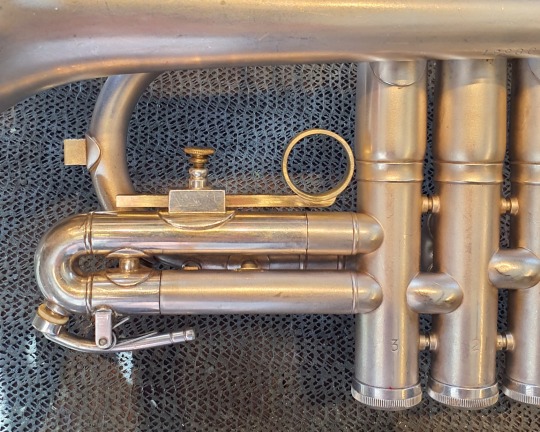
Old Eb cornet. Cleaned up nicely but was missing a ring trigger for the third slide and everything I had in my parts stash was too big to fit without a lot of filing, so I made one from scrap. Cut the rod from a length of brass stock and the ring from some brass tubing. Filed a crescent into the rod stock to make a larger contact area for the ring, then brazed them together, cleaned up a little bit of solder overrun, and polished it.
0 notes
Text

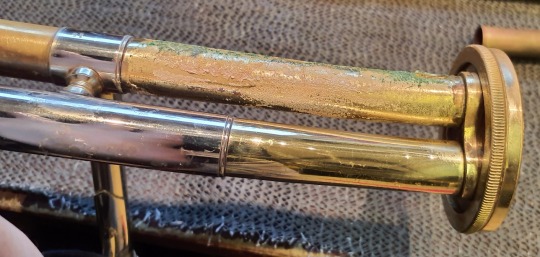


The result of using a strip of gaffer's tape on the gooseneck to protect it from the player's sweat and skin oils.
Llook, I get it, really. Some people have mega acidic body chemistry — I have seen trumpet valve casings eaten almost all the way through simply as a result of regular prolonged skin contact — and want an extra layer of something between body and instrument, be it a leather wrap or tape or whatever. But you gotta take that shit off now and then to clean under it, otherwise it starts looking like this.
#musical instrument repair#music#brass instrument#brasswind#musical instrument#trombone#Shires#this was just dirty#aesthetic and not structural#but if you leave it like this for too long it might start to damage it structurally too#or at least fuck up the lacquer or silver-plating
0 notes
Text

Thayer axial flow valve on a Shires trombone.
#musical instrument repair#brass instrument#musical instrument#trombone#Shires#thayer valve#Thayer axial flow valve#rotary valves#rotor valve
0 notes
Text

Go in thinking: "Okay, just quickly tweak the alignment so the trigger action is smoother," and end up disassembling and reassembling the whole tuning slide.
Twice.
Just been one of those days.

Fuck you, slide.
#musical instrument repair#music#brass instrument#brasswind#cornet#most fugly-ass soldering job I have done in a while#will hopefully look less bad after I buff and polish it#don't want to heat it up to flick off any excess in case the damn thing comes apart#again#might have been less annoying and looked less bad if the trigger assembly screw mount was more tightly fitted to the crook#but this one had so much empty space around it#real glad this is not a client's instrument#and instead comes from the shop's stash of “work on these when there is downtime in the workshop”#this is technically a new instrument#but the 1st slide trigger has been janky since we got it several years ago#finally fixing that
2 notes
·
View notes
Text

Different trombone on the bench same week as the one in the previous pst, with the same issue of misaligned inner handslide tubes.
1 note
·
View note
Text

Trombone took a bit of a tumble, and now the slide is all jacked up.
Those tubes are supposed to be parallel.
#musical instrument repair#music#brass instrument#brasswind#musical instrument#trombone#trombone slide#there were also some small dents in the outer handslide tubes from impacting the bell rim on the way down#not big enough to jam anything#but deep enough that you felt it catch slightly every time the rails moved past it
0 notes
Text


Bass trombone rotor before and after.
#musical instrument repair#music#brass instrument#brasswind#musical instrument#trombone#bass trombone#YBL-640G#rotary valve#before and after
3 notes
·
View notes
Text

Way off-centre pad in this bass clarinet key. Either it got bent out of alignment shortly after pad installation, or it was bent prior to that and whoever did the repad failed to notice. It was just barely sealing, and probably contributing to some of the notes in the upper register being difficult. Repositioned the key cup, ironed the pad to reduce the existing seat because I did not have this size bass clarinet pad in stock*, and reseated it, and now it seals evenly all the way around.
There were a few other keys on the upper joint that were leaking slightly, either due to pads not being level or being over- or under-adjusted to their neighbours. Biggest issue turned out to be the A/D key, which was slightly jiggly on its hinge rod. It closed just fine when activated directly by its own spatula, but when activated via connection to its neighbouring key it would pivot off centre by just enough to have the tiniest leak at the heel. Swedged it snug to the rod and now it's working fine.
* The ideal fix is replacing the pad because double-seating can lead to small leaks, but I see bass clarinets so infrequently that I don't keep the full range of possible pad sizes in the shop and instead just buy as needed, and the player couldn't wait that long.
0 notes
Note
Crazy wild question, did you go to Western Iowa tech?? I got rec'd your blog randomly and saw an old post where you mentioned going to a 2-year repair school. Just thought it was a funny coincidence, as I'm literally about to geaduate from WIT for BIR
Eyyy, repair tech fistbump. Welcome to the squad. Nah, I studied outside the USA. Heard good things about WIT though.
1 note
·
View note
Text

Client complaint: "The valves stick."
Me: Gee I wonder why.
#musical instrument repair#music#brass instrument#brasswind#musical instrument#euphonium#Boosey & Hawkes
3 notes
·
View notes